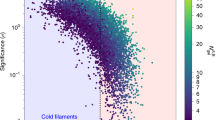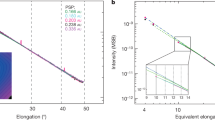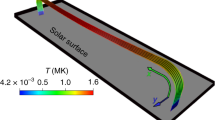Abstract
THAT the dark umbrae of sunspots are not uniformly dark has long been recognized1, but our knowledge of umbral structure is still limited. Here I present two white-light photographs of the solar disk, of different exposure, recently obtained during excep-tional seeing conditions with the McMath Telescope on Kitt Peak (Fig. 1). The shorter exposure reveals the solar granulation, and the longer brings out details in the darker umbrae. When these two images are suitably combined, the umbra of one small sunspot is resolved into an approximately filamentary structure, connecting to the penumbra, along with featureless voids. A 'light bridge9 partially spanning the spot is found to have a broader underlying filamentary foundation that completes the crossing. These photo-graphs suggest that the contemporary view of umbral structure as consisting primarily of granulation or 'umbral dots' is question-able. Given that a sunspot is a place where kilogauss magnetic fields concentrate and diverge outwards, filamentary brightness modulation can perhaps be attributed to partly inclined field lines, and the voids may be places where the field becomes perpendicular to the surface.
This is a preview of subscription content, access via your institution
Access options
Subscribe to this journal
Receive 51 print issues and online access
$199.00 per year
only $3.90 per issue
Buy this article
- Purchase on Springer Link
- Instant access to full article PDF
Prices may be subject to local taxes which are calculated during checkout
Similar content being viewed by others
References
Secchi, A. Le Soleil (Gauthier-Villars, Paris, 1875).
Bray, R. J. & Loughhead, R. E. Sunspots (Chapman and Hall, London, 1979).
Danielson, R. E. Astrophys. J. 139, 45–57 (1964).
Beckers, J. M. & Schröter, E. H. Solar Phys. 4, 303–314 (1968).
Adjabshirzadeh, A. & Koutchmy, S. Astr. Astrophys. 89, 88–94 (1980).
Soltau, D. Astr. Astrophys. 107, 211–213 (1982).
Garcia de la Rosa, J. I. in The Role of Fine-Scale Magnetic Fields on the Structure of the Solar Atmosphere (eds Schröter, E. H., Vázquez, M. & Wyller, A. A.) (Cambridge University Press, 1987).
Grossmann-Doerth, U., Schmidt, W. & Schröter, E. H. Astr. Astrophys. 156, 347–353 (1986).
Krat, V. A., Karpinsky, V. N. & Pravdjuk, L. M. Solar Phys. 26, 305–317 (1972).
Vázquez, M. Solar Phys. 31, 377–387 (1973).
Muller, R. Solar Phys. 61, 297–300 (1979).
Moore, R. L. The Physics of Sunspots (eds Cram, L. E. & Thomas, J. H.) 259–311 (National Solar Observatory, Sunspot, New Mexico, 1981).
Garcia de la Rosa, J. I. Solar Phys. 112, 49–58 (1987).
Papathanasoglou, D. Solar Phys. 21, 113–115 (1971).
Parker, E. N. Astrophys. J. 234, 333–347 (1979).
Author information
Authors and Affiliations
Rights and permissions
About this article
Cite this article
Livingston, W. Radial filamentary structure in a sunspot umbra. Nature 350, 45–46 (1991). https://doi.org/10.1038/350045a0
Received:
Accepted:
Issue Date:
DOI: https://doi.org/10.1038/350045a0
This article is cited by
-
Sunspot Bright Points
Solar Physics (2013)
Comments
By submitting a comment you agree to abide by our Terms and Community Guidelines. If you find something abusive or that does not comply with our terms or guidelines please flag it as inappropriate.



